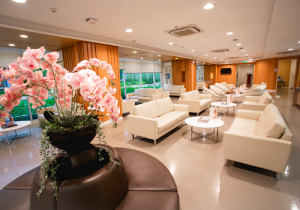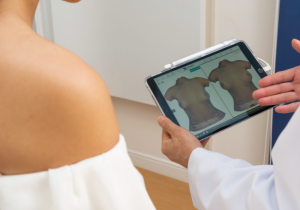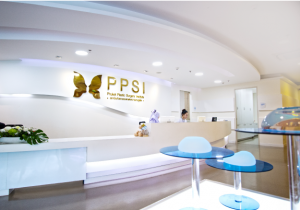Breast lift
Breast lift surgery, also known as mastopexy, is a procedure that lifts, raises, and firms the breasts. The excess skin is removed to tighten the surrounding tissue and to reshape and support the new breast contour.
It is very common for women who believe their breasts are “empty”, especially after pregnancy. Contrary to popular belief and some false advertising- an implant alone will not magically lift or raise the breasts. If there is any degree of breast ptosis (sagging) as determined by a plastic surgeon, or the nipples are not in a good position (which is very common and occurs in approximately 50-60% of women) a breast augmentation alone will not give a good result.
The internal breast tissue is reshaped and designed to reshape and tighten the breast contour by removing excess skin. This gives the breasts a more firm and raised appearance. It is a good procedure for clients with the following expectations:
It is very common for women who believe their breasts are “empty”, especially after pregnancy. Contrary to popular belief and some false advertising- an implant alone will not magically lift or raise the breasts. If there is any degree of breast ptosis (sagging) as determined by a plastic surgeon, or the nipples are not in a good position (which is very common and occurs in approximately 50-60% of women) a breast augmentation alone will not give a good result.
The internal breast tissue is reshaped and designed to reshape and tighten the breast contour by removing excess skin. This gives the breasts a more firm and raised appearance. It is a good procedure for clients with the following expectations:

Surgical Procedure
During surgery, the surgeon removes excess skin and tightens the remaining skin. The surgeon starts by assessing the required lift and fullness needed to achieve the desired result by marking a new nipple position using a scalpel.
The surgeon then makes an incision along the pre-marked lines and separates the skin from the tissues below. The excess breast fat is then removed, the nipple relocated to its new position and finally, the new breast shape is reconstructed. The incision is usually made around the nipple and under the surface of the breast, like an upside-down T, however, a different technique may be used depending on the degree to which your breasts sag.
The surgeon then makes an incision along the pre-marked lines and separates the skin from the tissues below. The excess breast fat is then removed, the nipple relocated to its new position and finally, the new breast shape is reconstructed. The incision is usually made around the nipple and under the surface of the breast, like an upside-down T, however, a different technique may be used depending on the degree to which your breasts sag.
Pre-Operative Care
Before surgery please inform your surgeon of any allergies, all medical conditions, and any medication that you are taking (both prescription and non-prescription).
To eliminates the chance of post-op. bleeding, you should avoid aspirin and any medication containing aspirin or ibuprofen for 2 weeks prior to surgery as well as smoking.
In your consultation, you should discuss your expectations of the outcome of the surgery and listen to the surgeon’s opinion. As you have already sent photos of your breasts to the surgeon prior to the consultation. This will enable the assessment and also serve as a reference following surgery.
Breast lift surgery is a highly individualized procedure and may not be suitable for everyone.
To eliminates the chance of post-op. bleeding, you should avoid aspirin and any medication containing aspirin or ibuprofen for 2 weeks prior to surgery as well as smoking.
In your consultation, you should discuss your expectations of the outcome of the surgery and listen to the surgeon’s opinion. As you have already sent photos of your breasts to the surgeon prior to the consultation. This will enable the assessment and also serve as a reference following surgery.
Breast lift surgery is a highly individualized procedure and may not be suitable for everyone.
Post Operative Care
Upon waking after surgery, you will be wrapped in elastic bandages, gauze dressings, and a surgical bra with a small tube placed in each breast to drain blood and fluids for the first couple of days.
There will be some bruising extent of the post-operative swelling and bruising depends on whether you tend to bruise easily as everyone is different. The use of cold compresses or ice packs applied to the area will reduce swelling and relieve discomfort.
A couple of days after surgery the pressure bandages will be removed and a surgical bra must be worn at all times for several weeks. This is until the swelling and bruising subside, or until your surgeon advises you otherwise. You should only remove the surgical bra to bathe and to wash the garment.
Usually, the sutures will be removed in the first week however sometimes the surgeon will use dissolvable sutures. If the breast skin is very dry following surgery, a moisturizer can be applied several times a day. Vitamin E cream is extremely effective and also helps the scarring to heal, however, the suture area must be kept dry at all times, particularly after bathing.
For the first few months, it is important not to place tension on the wound by performing strenuous activities like lifting or stretching your arms above your head, as this may increase scarring by stretching the tissue. You will need assistance to pushing your trolley, holding your children, carry your groceries, or hang your washing!
Your surgeon will try to ensure that your incisions as subtle as possible, however, it is important to remember that the scars are extensive and permanent. They may be red for months, and then slowly become fainter, eventually fading to thin white lines. In most cases, the scars are positioned so that they would not be seen if you wear low-cut tops and dresses.
Recovery usually takes about 2 weeks however most people are back to work within 3 weeks.
There will be some bruising extent of the post-operative swelling and bruising depends on whether you tend to bruise easily as everyone is different. The use of cold compresses or ice packs applied to the area will reduce swelling and relieve discomfort.
A couple of days after surgery the pressure bandages will be removed and a surgical bra must be worn at all times for several weeks. This is until the swelling and bruising subside, or until your surgeon advises you otherwise. You should only remove the surgical bra to bathe and to wash the garment.
Usually, the sutures will be removed in the first week however sometimes the surgeon will use dissolvable sutures. If the breast skin is very dry following surgery, a moisturizer can be applied several times a day. Vitamin E cream is extremely effective and also helps the scarring to heal, however, the suture area must be kept dry at all times, particularly after bathing.
For the first few months, it is important not to place tension on the wound by performing strenuous activities like lifting or stretching your arms above your head, as this may increase scarring by stretching the tissue. You will need assistance to pushing your trolley, holding your children, carry your groceries, or hang your washing!
Your surgeon will try to ensure that your incisions as subtle as possible, however, it is important to remember that the scars are extensive and permanent. They may be red for months, and then slowly become fainter, eventually fading to thin white lines. In most cases, the scars are positioned so that they would not be seen if you wear low-cut tops and dresses.
Recovery usually takes about 2 weeks however most people are back to work within 3 weeks.
Risks and Complications
A breast lift does not prevent future breast-feeding as a breast reduction procedure sometimes can.
The scars will fade gradually but nipple numbness may take up to 12 months before sensation returns.
Risks are inherent to any surgical procedure. The most common risks are swelling, bruising, bleeding, infection, fluid, scarring, numbness, or a change in sensation to the nipple. The most common risk particular to this surgery is damage to the nerve and blood supply of the nipple and in some cases this could lead to a loss of feeling in the nipples.
The scars will fade gradually but nipple numbness may take up to 12 months before sensation returns.
Risks are inherent to any surgical procedure. The most common risks are swelling, bruising, bleeding, infection, fluid, scarring, numbness, or a change in sensation to the nipple. The most common risk particular to this surgery is damage to the nerve and blood supply of the nipple and in some cases this could lead to a loss of feeling in the nipples.
























